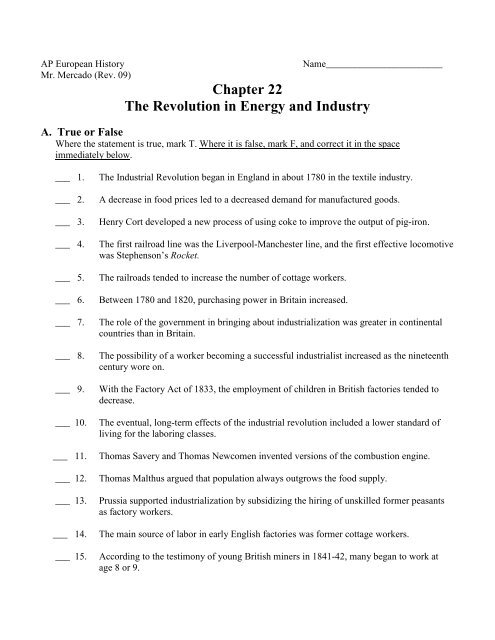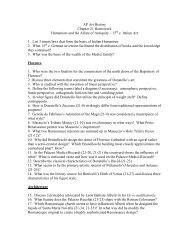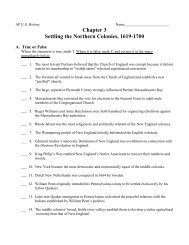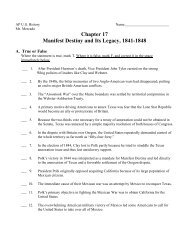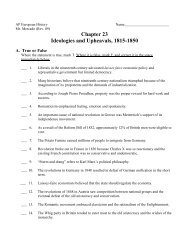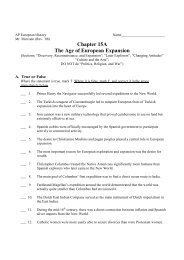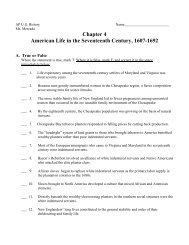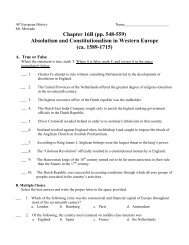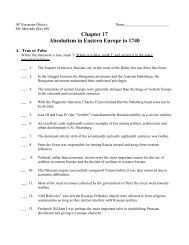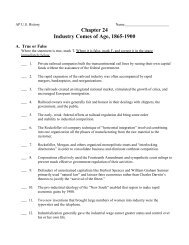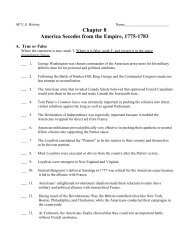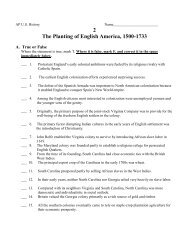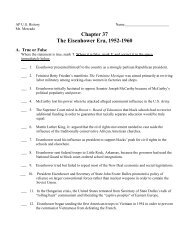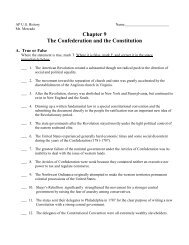Chapter 22 The Revolution in Energy and Industry - Main
Chapter 22 The Revolution in Energy and Industry - Main
Chapter 22 The Revolution in Energy and Industry - Main
You also want an ePaper? Increase the reach of your titles
YUMPU automatically turns print PDFs into web optimized ePapers that Google loves.
AP European HistoryMr. Mercado (Rev. 09)<strong>Chapter</strong> <strong>22</strong><strong>The</strong> <strong>Revolution</strong> <strong>in</strong> <strong>Energy</strong> <strong>and</strong> <strong>Industry</strong>Name________________________A. True or FalseWhere the statement is true, mark T. Where it is false, mark F, <strong>and</strong> correct it <strong>in</strong> the spaceimmediately below.___ 1.___ 2.___ 3.___ 4.___ 5.___ 6.___ 7.___ 8.___ 9.___ 10.___ 11.___ 12.___ 13.___ 14.___ 15.<strong>The</strong> Industrial <strong>Revolution</strong> began <strong>in</strong> Engl<strong>and</strong> <strong>in</strong> about 1780 <strong>in</strong> the textile <strong>in</strong>dustry.A decrease <strong>in</strong> food prices led to a decreased dem<strong>and</strong> for manufactured goods.Henry Cort developed a new process of us<strong>in</strong>g coke to improve the output of pig-iron.<strong>The</strong> first railroad l<strong>in</strong>e was the Liverpool-Manchester l<strong>in</strong>e, <strong>and</strong> the first effective locomotivewas Stephenson’s Rocket.<strong>The</strong> railroads tended to <strong>in</strong>crease the number of cottage workers.Between 1780 <strong>and</strong> 1820, purchas<strong>in</strong>g power <strong>in</strong> Brita<strong>in</strong> <strong>in</strong>creased.<strong>The</strong> role of the government <strong>in</strong> br<strong>in</strong>g<strong>in</strong>g about <strong>in</strong>dustrialization was greater <strong>in</strong> cont<strong>in</strong>entalcountries than <strong>in</strong> Brita<strong>in</strong>.<strong>The</strong> possibility of a worker becom<strong>in</strong>g a successful <strong>in</strong>dustrialist <strong>in</strong>creased as the n<strong>in</strong>eteenthcentury wore on.With the Factory Act of 1833, the employment of children <strong>in</strong> British factories tended todecrease.<strong>The</strong> eventual, long-term effects of the <strong>in</strong>dustrial revolution <strong>in</strong>cluded a lower st<strong>and</strong>ard ofliv<strong>in</strong>g for the labor<strong>in</strong>g classes.Thomas Savery <strong>and</strong> Thomas Newcomen <strong>in</strong>vented versions of the combustion eng<strong>in</strong>e.Thomas Malthus argued that population always outgrows the food supply.Prussia supported <strong>in</strong>dustrialization by subsidiz<strong>in</strong>g the hir<strong>in</strong>g of unskilled former peasantsas factory workers.<strong>The</strong> ma<strong>in</strong> source of labor <strong>in</strong> early English factories was former cottage workers.Accord<strong>in</strong>g to the testimony of young British m<strong>in</strong>ers <strong>in</strong> 1841-42, many began to work atage 8 or 9.
McKay Ch. <strong>22</strong> Homework Packet Page 2B. Multiple ChoiceSelect the best answer <strong>and</strong> write the proper letter <strong>in</strong> the space provided.____________1. In the 1830s, the most technologically advanced country <strong>in</strong> the world wasa. Belgium. b. the United States c. France d. Brita<strong>in</strong>2. Which of the follow<strong>in</strong>g was a period of fall<strong>in</strong>g real wages for English workers?a. 1792-1815 b. 1815-1850 c. 1840-1850 d. 1850-18903. <strong>The</strong> first large factories produceda. wool textiles. b. cotton textiles c. iron <strong>and</strong> steel d. furniture4. Which of the follow<strong>in</strong>g was most likely to characterize a cottage worker?a. Worked at his or her own paceb. Never worked alongside other members of his or her familyc. Worked at a steady <strong>and</strong> constant rated. Would probably prefer factory work to domestic <strong>in</strong>dustry work___ 5. All of the follow<strong>in</strong>g were reasons for why Brita<strong>in</strong> was the first to <strong>in</strong>dustrialize EXCEPTa. Brita<strong>in</strong> already enjoyed a large market <strong>in</strong> the form of its empire.b. Brita<strong>in</strong> had developed advanced agriculture that produced a surplus.c. Brita<strong>in</strong> had a central bank as well as a good canal system.d. Brita<strong>in</strong> had a domestic market with many local protective barriers.___ 6. <strong>The</strong> energy crisis of the eighteenth <strong>and</strong> n<strong>in</strong>eteenth centuries was solved by reliance ona. wood b. coal <strong>and</strong> steam c. electricity d. water power___7. Accord<strong>in</strong>g to Friedrich List, the promotion of <strong>in</strong>dustrya. was dangerous for the well-be<strong>in</strong>g of the peasants.b. was vital for the defense of the nation.c. <strong>in</strong>creased the poverty of the population.d. required free trade between nations.___ 8. <strong>The</strong> most significant technological advance made dur<strong>in</strong>g the Industrial <strong>Revolution</strong> was thea. first large factory. b. cotton-sp<strong>in</strong>n<strong>in</strong>g jenny c. steam eng<strong>in</strong>e d. water frame______9. Which of the follow<strong>in</strong>g was passed by the British Parliament to outlaw unions <strong>and</strong> strikes?a. <strong>The</strong> Factory Act of 1833 b. <strong>The</strong> Comb<strong>in</strong>ation Actsc. <strong>The</strong> M<strong>in</strong>es Act of 1842 d. <strong>The</strong> Gr<strong>and</strong> National Consolidated Trades Union Act10. <strong>The</strong> Industrial <strong>Revolution</strong> <strong>in</strong> Francea. developed at a faster pace than it did <strong>in</strong> Germany.b. developed more rapidly than <strong>in</strong> Brita<strong>in</strong>.c. occurred largely prior to 1780.d. lagged beh<strong>in</strong>d that of Brita<strong>in</strong>.
McKay Ch. <strong>22</strong> Homework Packet Page 3___11. <strong>The</strong> growth of the railroad caused all of the follow<strong>in</strong>g EXCEPTa. a reduction <strong>in</strong> the cost of overl<strong>and</strong> freight.b. an <strong>in</strong>crease <strong>in</strong> the dem<strong>and</strong> for cottage <strong>in</strong>dustry goods.c. the growth of a class of urban workers.d. the widen<strong>in</strong>g of markets___ 12. <strong>The</strong> first cont<strong>in</strong>ental country to <strong>in</strong>dustrialize wasa. Belgium. b. France c. Italy d. Germany___13. <strong>The</strong> <strong>in</strong>dustrial development of cont<strong>in</strong>ental Europe was delayed bya. a lack of resources. b. the French <strong>Revolution</strong> <strong>and</strong> Napoleonic wars.c. the plague. d. a labor shortage.___ 14. Before the 1830s, thea. family cont<strong>in</strong>ued to work as a unit <strong>in</strong> the factories.b. factory employed only females.c. mother <strong>and</strong> father worked together while their children went to factory schools.d. factory employed only the males.___ 15. <strong>The</strong> British workers’ campaign to ga<strong>in</strong> the franchise between 1838 <strong>and</strong> 1848 was called thea. Ten-Hours’ movement. b. Luddite movementc. Chartist movement d. democratic movement___ 16. Which of the follow<strong>in</strong>g was NOT characteristic of Robert Owen?a. He was a scholar who wanted to implement his socialist ideas.b. He experimented with cooperative <strong>and</strong> socialist communities.c. He organized one of Brita<strong>in</strong>’s first national unions.d. He tried to improve the work<strong>in</strong>g conditions of his workers.___ 17. <strong>The</strong> first factories werea. steel mills. b. chemical firms c. cloth<strong>in</strong>g companies d. textile mills_________18. <strong>The</strong> early <strong>in</strong>dustrialists <strong>in</strong> Brita<strong>in</strong> very often werea. aristocrats tak<strong>in</strong>g advantage of new economic opportunities.b. members of the established church.c. Irish immigrants.d. Quakers <strong>and</strong> Scots.19. Workers who smashed the mach<strong>in</strong>es that put them out of work were known asa. Luddites. b. anti-Modernists c. Chartists d. apprentices20. William Cockerill’s cotton-sp<strong>in</strong>n<strong>in</strong>g plant <strong>in</strong> Belgium was controversial becausea. he employed only women.b. he had illegally exported technology from Brita<strong>in</strong>.c. he had to bribe government officials to obta<strong>in</strong> the necessary permits.d. he required his workers to convert to Catholicism to keep their jobs.
McKay Ch. <strong>22</strong> Homework Packet Page 4_________21. By the end of the n<strong>in</strong>eteenth century large decreases <strong>in</strong> per capital <strong>in</strong>dustrial levels hadoccurred <strong>in</strong>a. India <strong>and</strong> Ch<strong>in</strong>a. b. France c. Brita<strong>in</strong> d. Germany<strong>22</strong>. For women, the Industrial <strong>Revolution</strong>a. provided a greater chance of economic equality with men.b. discouraged marriage <strong>and</strong> children.c. provided new career opportunities <strong>in</strong> high-level jobs.d. caused them to be conf<strong>in</strong>ed to low-pay<strong>in</strong>g, dead-end jobs.23. It appears that dur<strong>in</strong>g the Industrial <strong>Revolution</strong> <strong>in</strong> Brita<strong>in</strong> the gross national producta. rose at about the same rate as the per capita consumption of goods.b. rose more rapidly than the per capita consumption of goods.c. rose less rapidly than the per capita consumption of goods.d. fell below the per capita consumption of goods.C. Match<strong>in</strong>gMatch the person, place, or event <strong>in</strong> the left column with the proper description <strong>in</strong> the right column by<strong>in</strong>sert<strong>in</strong>g the correct letter on the blank l<strong>in</strong>e.___ 1. James Watt___ 2. Crystal Palace___ 3. Zollvere<strong>in</strong>___ 4. Comb<strong>in</strong>ation Acts of 1799___ 5. Richard Arkwright___ 6. James Hargreaves___ 7. Edmund Cartwright___ 8. David RicardoA. Inventor of an improved sp<strong>in</strong>n<strong>in</strong>g mach<strong>in</strong>e called the waterframeB. Economist who believed that an “iron law of wages” wouldresult from overpopulationC. Romantic poet who criticized the impact of <strong>in</strong>dustrialismon the environment <strong>in</strong> the countrysideD. Corporate bank <strong>in</strong> Paris that pooled the resources of manysmall <strong>in</strong>vestors to fund major railroad projectsE. Inventor of the first truly efficient steam eng<strong>in</strong>eF. Inventor of the power loom that <strong>in</strong>creased the speed ofweav<strong>in</strong>gG. Laws that outlawed the formation of labor unions or strikesH. Inventor of the sp<strong>in</strong>n<strong>in</strong>g jenny___ 9. Crédit Mobilier I. Writer who accused the middle-class of ruthlesslyexploit<strong>in</strong>g the work<strong>in</strong>g class dur<strong>in</strong>g the <strong>in</strong>dustrialrevolution___ 10. William WordsworthJ. Customs union <strong>in</strong> the German states that provided for freetrade among member states___ 11. Friedrich Engels K. Location of London’s great <strong>in</strong>dustrial fair of 1851


